Discover 50 hidden attractions, cool sights, and unusual things to do in Sri Lanka. Don't miss out on these must-see attractions: Temple of the Tooth (Kandy), Royal Botanical Gardens (Kandy) or National Zoological Gardens of Sri Lanka (Colombo).
Below, you can find the list of the most amazing places you should visit in Sri Lanka.
Table of Contents
Temple of the Tooth, Kandy

Also known as: ශ්රී දළදා මාළිගාව
1595 temple with the sacred Tooth Relic. The Temple of the Sacred Tooth Relic or Sri Dalada Maligawa, commonly known as the Glorious Tooth Temple, is a Buddhist temple in Kandy, Sri Lanka. It is located in the royal palace complex of the former Kingdom of Kandy, which houses the relic of the tooth of the Buddha. Since ancient times, the relic has played an important role in local politics because it is believed that whoever holds the relic holds the governance of the country. The relic was historically held by Sinhalese kings. The temple of the tooth is a World Heritage Site mainly due to the temple and the relic.
Bhikkhus of the two particular chapters, the Malwathu chapters and Asgiri chapters, conduct daily worship in the inner chamber of the temple. Rituals are performed three times daily: at dawn, at noon and in the evenings. On Wednesdays, there is a symbolic bathing of the relic with a herbal preparation made from scented water and fragrant flowers called Nanumura Mangallaya; this holy water is believed to contain healing powers and is distributed to those present.
The temple sustained damage from bombings by Janatha Vimukthi Peramuna in 1989, and by the Liberation Tigers of Tamil Eelam in 1998. However, it was fully restored each time.[1]
Address: Sri Dalada Veediya, 20000 මහනුවර
Royal Botanical Gardens, Kandy
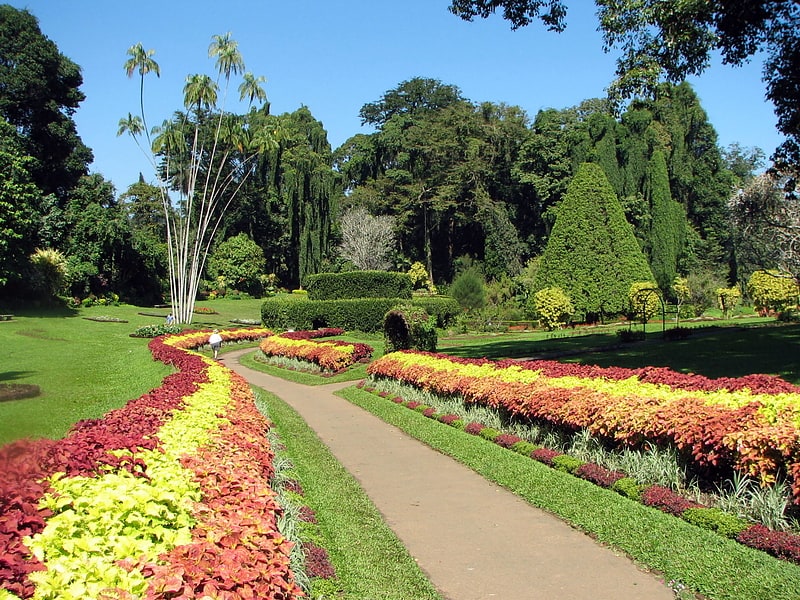
Also known as: රාජකීය උද්භිද උද්යානය, ශ්රී ලංකාව
Sprawling garden with flowers and plants. Royal Botanic Gardens, Peradeniya are about 5.5 km to the west of the city of Kandy in the Central Province of Sri Lanka. In 2016, the garden was visited by 1.2 million locals and 400,000 foreign visitors. It is near the Mahaweli River. It is renowned for its collection of orchids. The garden includes more than 4000 species of plants, including orchids, spices, medicinal plants and palm trees. Attached to it is the "National Herbarium of Sri Lanka". The total area of the botanical garden is 147 acres, at 460 meters above sea level, and with a 200-day annual rainfall. It is managed by the Division of National Botanic Gardens of the Department of Agriculture.[2]
Address: Peradeniya Road, 20400 Peradeniya
National Zoological Gardens of Sri Lanka, Colombo
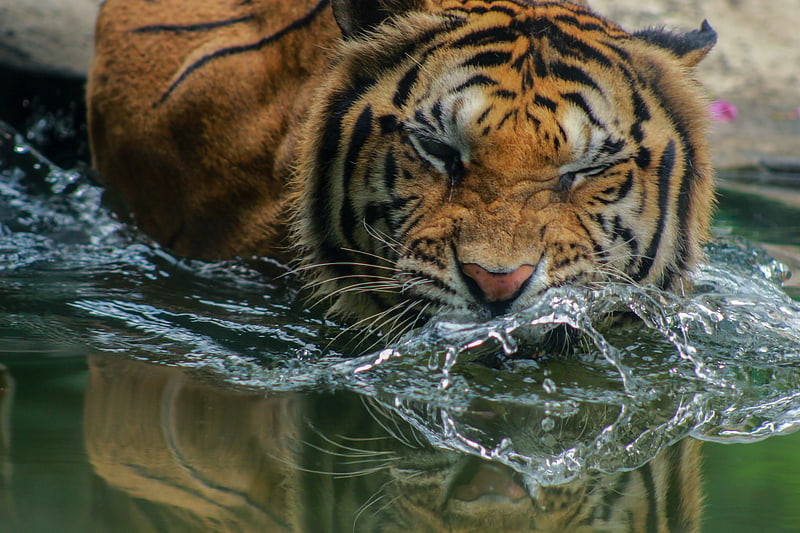
Also known as: දෙහිවල ජාතික සත්වෝද්යානය
Landscaped zoo with a butterfly garden. National Zoological Gardens of Sri Lanka is a zoological garden in Dehiwala, Sri Lanka, founded in 1936. Its sprawling areas are host to a variety of animals and birds. The zoo exhibits animals but also places an emphasis on animal conservation and welfare, and education. The current Director-General of the zoo is Shermila Rajapaksha.
The zoo has 3000 animals and 350 species as of 2005. The annual revenue is LKR 40 million.
The zoo dehiwala exchanges its residents with other zoological gardens for breeding purposes. In June 2021, it was reported that a lion named Thor which has been living in the zoo since 2012 has reportedly tested positive for COVID-19.[3]
Address: Anagarika Dharmapala Mawatha, 10350 Colombo
Galle Face Green, Colombo
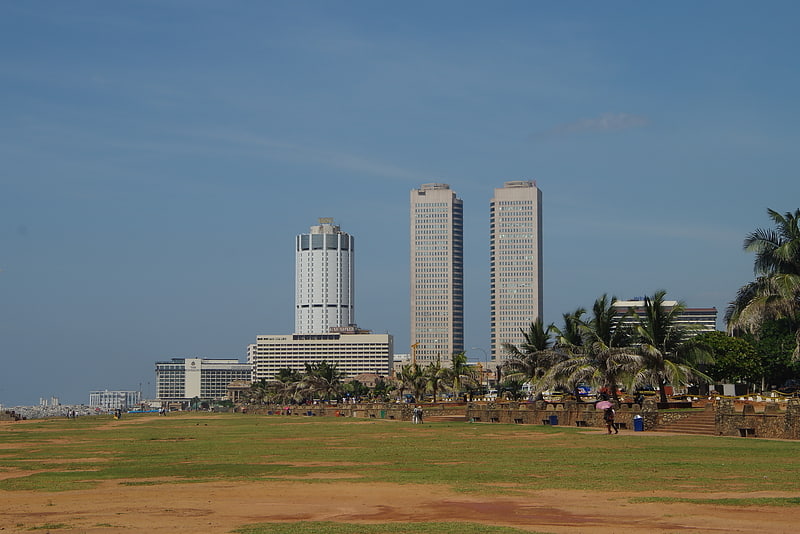
Also known as: ගාලු මුවදොර පිටිය
Scenic waterfront area with food stalls. Galle Face is a 5 ha ocean-side urban park, which stretches for 500 m along the coast, in the heart of Colombo, the financial and business capital of Sri Lanka. The promenade was initially laid out in 1859 by Governor Sir Henry George Ward, although the original Galle Face Green extended over a much larger area than is seen today. The Galle Face Green was initially used for horse racing and as a golf course, but was also used for cricket, polo, football, tennis, and rugby.[4]
Address: Colombo, Western, Sri Lanka, 00300 කොළඹ (District 2B)
National Museum of Kandy, Kandy
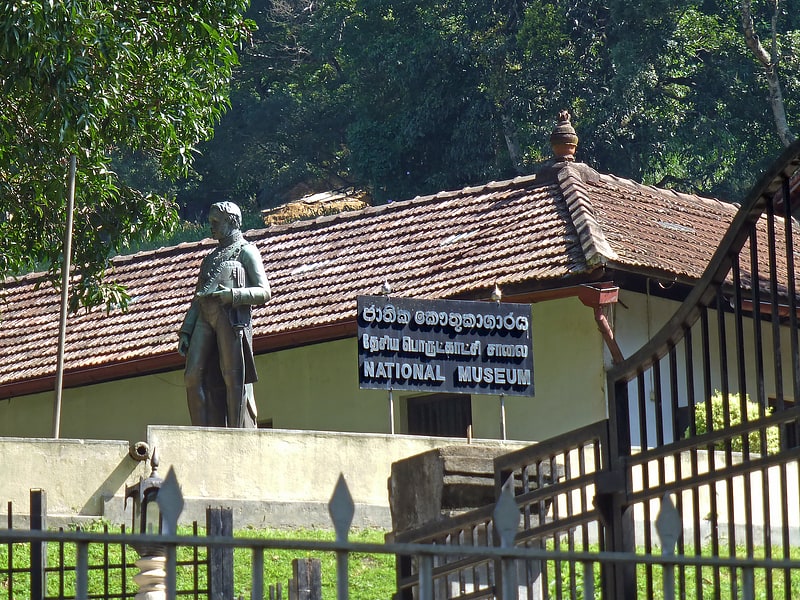
Also known as: මහනුවර ජාතික කෞතුකාගාරය
Museum in Kandy, Sri Lanka. The National Museum of Kandy in Kandy, Sri Lanka is located next to the Temple of the Tooth in part of the former Royal Palace of Kandy. The primary exhibits are housed in the Palle Vahala building, which was the former home of the King's harem. A secondary exhibition is located in the main palace building. The museum is maintained by the Department of National Museums.
The Palle Vahala (lower palace) or Meda Vahala (middle palace) was constructed during the Sri Vickrama Rajasingha era and was used as the quarters of the queens of King of Kandy. This building has been built according to the architectural features of Kandy period. It was used as a depository for historical artifacts made by the Kandy Art Association which was established in 1882 and artisans of Matale. The museum was opened to the public in 1942.
The museum has over 5,000 artifacts on display consist of weapons, jewelry, tools and other artifacts from the Kandian era (17-19th Century) and post British Colonial era, including a copy of the 1815 agreement that handed over the Kandyan provinces to the British. In the grounds of the museum is a statue of Sir Henry Ward a former Governor of Ceylon (1855–1860), which was originally located in front of the Queen's Hotel.[5]
Address: National Museum, Kandy, Central Province, 20000 Kandy
Baker's Falls, Horton Plains
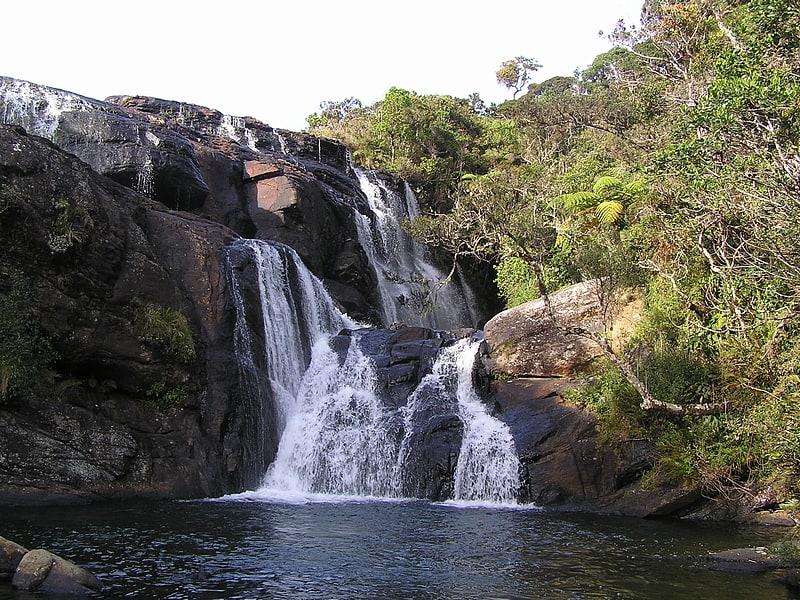
Also known as: බේකර්ස් ඇල්ල
Waterfall in Sri Lanka. Baker's Falls is a famous waterfall in Sri Lanka. It is located in the Horton Plains National Park, on a tributary of the Belihul Oya.
The height of the Baker's waterfalls is 20 metres (66 ft). The falls were named after British explorer and big game hunter, Sir Samuel Baker. Many Rhododendron and Fern bushes can be seen around the waterfall.[6]
Koneswaram temple, Trincomalee
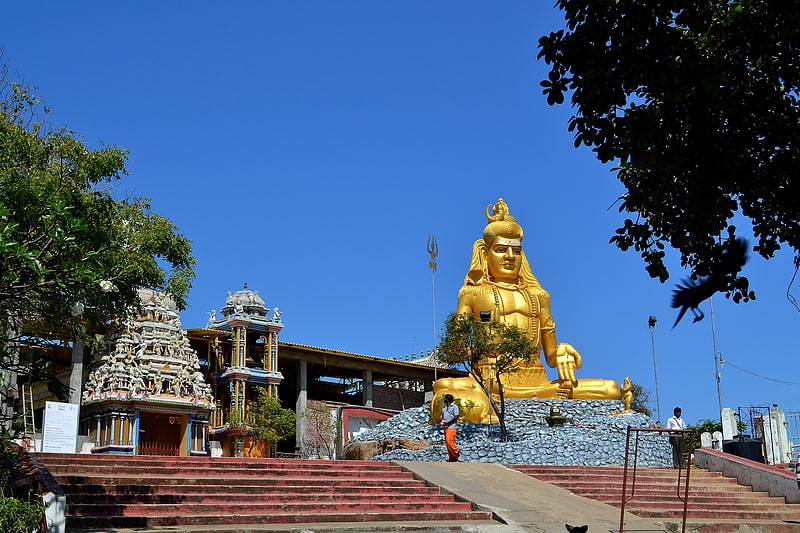
Hindu temple in Trincomalee, Sri Lanka. Koneswaram temple of Trincomalee or Thirukonamalai Konesar Temple – The Temple of the Thousand Pillars and Dakshina-Then Kailasam is a classical-medieval Hindu temple complex in Trincomalee, a Hindu religious pilgrimage centre in Eastern Province, Sri Lanka. The most sacred of the Pancha Ishwarams of Sri Lanka, it was built significantly during the reign of the early Cholas and the Five Dravidians of the Early Pandyan Kingdom on top of Konesar Malai, a promontory overlooking Trincomalee District, Gokarna bay and the Indian Ocean. Its Pallava, Chola, Pandyan and Jaffna design reflect a continual Tamil Saivite influence in the Vannimai region from the classical period. The monument contains its main shrine to Shiva in the form Kona-Eiswara, shortened to Konesar. Connected at the mouth of the Mahavilli Ganga River to the footprint of Shiva at Sivan Oli Padam Malai at the river's source, the temple symbolically crowns the flow of the Ganges River from Shiva's head of Mount Kailash to his feet.
Developed from 205 BC, the original kovil combined key features to form its basic Dravidian temple plan, such as its thousand pillared hall – "Aayiram Kaal Mandapam" – and the Jagati expanded by King Elara Manu Needhi Cholan. Regarded as the greatest building of its age for its architecture, elaborate sculptural bas-relief ornamentation adorned a black granite megalith while its multiple gold plated gopuram towers were expanded in the medieval period. One of three major Hindu shrines on the promontory with a colossal gopuram tower, it stood distinctly on the cape's highest eminence.
The journey for pilgrims in the town begins at the opening of Konesar Road and follows a path through courtyard shrines of the compound to the deities Bhadrakali, Ganesh, Vishnu Thirumal, Surya, Raavana, Ambal-Shakti, Murukan and Shiva who presides at the promontory's height. The annual Koneswaram Temple Ther Thiruvilah festival involves the Bhadrakali temple of Trincomalee, the Pavanasam Theertham at the preserved Papanasuchunai holy well and the proximal Back Bay Sea (Theertham Karatkarai) surrounding Konesar Malai.
The Sinhalese king Gajabahu II who ruled Polonnaruwa from 1131 to 1153 AD is described in the Konesar Kalvettu as a devout worshipper of Lord Shiva and a benefactor of the temple of Konamalai. He spent his last days in the associated Brahmin settlement of Kantalai.
The complex was destroyed in colonial religious attacks between 1622 and 1624 and a fort was built at the site from its debris. A 1632 built temple located away from the city houses some of its original idols. Worldwide interest was renewed following the discovery of its underwater and land ruins, sculptures and Chola bronzes by archaeologists and Arthur C. Clarke. It has been preserved through restorations, most recently in the 1950s. Granted ownership of villages in its floruit to form the Trincomalee District, Trincomalee village is located on the cape isthmus within the compounds. Revenue from the temple provides services and food to local residents.
Koneswaram has many strong historical associations. The shrine is described in the Vayu Purana, the Konesar Kalvettu and Tevaram hymns by Sambandhar and Sundarar as a Paadal Petra Sthalam along with its west coast Ishwaram counterpart Ketheeswaram temple, Mannar, and was praised for its tradition by Arunagirinathar upon his visit. The Dakshina Kailasa Puranam and Manmiam works note it as Dakshina/Then Kailasam (Mount Kailash of the South) for its longitudinal position and pre-eminence, it lies directly east of Kudiramalai west coast Hindu port town, while it is the easternmost shrine of the five ancient Ishwarams of Shiva on the island.
Mentioned as a widely popular bay temple of the island in the Mahabharata, Ramayana and Yalpana Vaipava Malai, the Mattakallappu Manmiam confirms its sacred status for all Hindus. Kachiyappa Sivachariar's Kanda Puranam compares the temple to Thillai Chidambaram Temple and Mount Kailash in Saivite esteem. Konesar Malai may have been the site where Yoga originated; some scholars have suggested that the worship of the almighty god Eiswara on the promontory is the most ancient form of worship existing.[7]
Ruwanwelisaya, Anuradhapura
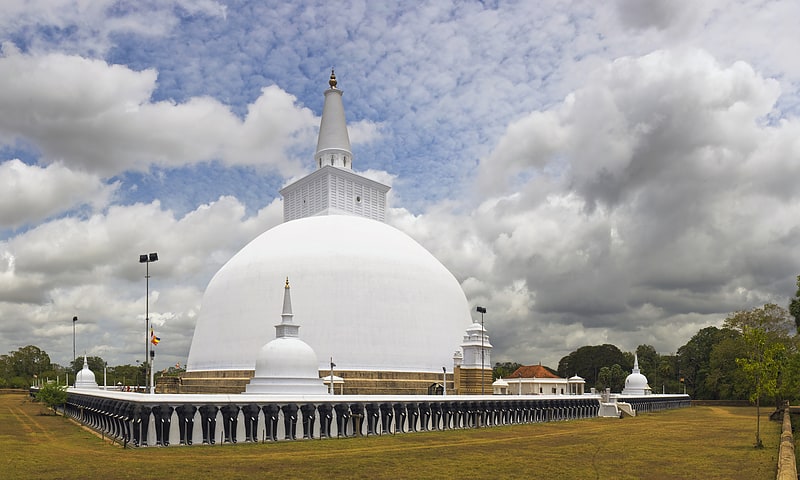
Also known as: රුවන්වැලිසෑය
Pagoda in Anuradhapura, Sri Lanka. The Ruwanweli Maha Seya, also known as the Mahathupa is a stupa in Anuradhapura, Sri Lanka. Two quarts or one Dona of the Buddha's relics are enshrined in the stupa, making it the largest collection of his relics anywhere. It was built by Sinhalese King Dutugemunu in c. 140 B.C. who became king of Sri Lanka after a war in which the Chola King Elāra was defeated. It is also known as Swarnamali Seya, Svaṇṇamāli Mahaceti and Rathnamali Seya.
This is one of the "Solosmasthana" (the 16 places of veneration) and the "Atamasthana" (the 8 places of veneration). The stupa is one of the world's tallest ancient monuments, standing at 103 m (338 ft) and with a circumference of 290 m (951 ft). The original stupa had been about 55 m (180 ft) in height and was renovated by many kings. The Kaunghmudaw Pagoda in Sagaing, Myanmar is modelled after this stupa The Mahavamsa contains a detailed account on the construction and the opening ceremony of the stupa.
The stupa was covered by jungle as of the 19th century. After fund raising efforts by a bhikkhu, it was renovated in the early 20th century. The Ruwanweli Seya Restoration Society, most notably the philanthropist Hendrick Appuhamy, donated Rs 20 million (1912) for the restoration works, the foundation was founded in 1902 and the final crowning of the stupa took place on 17 June 1940.[8]
Address: Abhayawewa Rd, 50000 Anuradhapura
Kelaniya Raja Maha Vihara, Colombo

Also known as: කැලණිය රජ මහා විහාරය
Buddhist temple in Peliyagoda, Sri Lanka. The Kelaniya Raja Maha Vihara or Kelaniya Temple is a Buddhist temple in Kelaniya, Sri Lanka. It is located 11 km north-east of Colombo. The current chief incumbent is Venerable Professor Kollupitiye Mahinda Sangharakkhitha Thera.
The temple has often been associated with the rise and fall of Ceylon / Sri Lanka, with the popular saying that as the Kelaniya temple rose, Sri Lanka rose and as it fell, the country and its administration fell. It has thus had a deep association with the political powers of the country.
It is also infamous for Mapitigama Buddharakkitha, the chief conspirator of the 1959 assassination of Ceylon's fourth Prime Minister S. W. R. D. Bandaranaike. Buddharakkitha was the chief incumbent (chief priest) of the Kelaniya Raja Maha Vihara from 1947 to 1959.[9]
Gal Vihara, Polonnaruwa
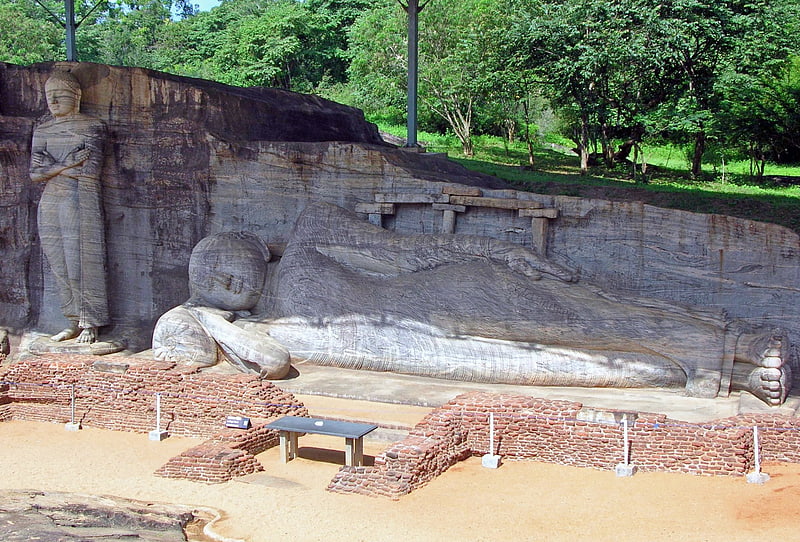
Also known as: ගල් විහාරය
Buddhist temple in Nissankamallapura, Sri Lanka. The Gal Vihara, and originally as the Uttararama, is a rock temple of the Buddha situated in the ancient city of Polonnaruwa in North Central Province, Sri Lanka. It was fashioned in the 12th century by Parakramabahu I. The central feature of the temple is four rock relief statues of the Buddha, which have been carved into the face of a large granitic rock. The images consist of a large seated figure, another smaller seated figure inside an artificial cavern, a standing figure and a reclining figure. These are considered to be some of the best examples of ancient Sinhalese sculpting and carving arts, and have made the Gal Vihara the most visited monument at Polonnaruwa.
The images of Uttararama follow a different style from the images of the previous Anuradhapura period, and show some significant differences. The identity of the standing image is subject to a certain amount of dispute among historians and archaeologists, some of whom argue that it depicts the monk Ananda rather than the Buddha. Each of the images have been carved in a way that uses a maximum possible area of the rock, and their heights seem to have been decided based on the height of the rock itself. Each statue appears to have had its own image house, as indicated by the remains of brick walls at the site. The Uttararama was where Parakramabahu I held a congregation of monks to purify the Buddhist priesthood, and later drew up a code of conduct for them. This code of conduct has been recorded in an inscription on the same rock face containing the images of the Buddha.[10]
Address: KandeVihara Rd, Aluthgama, Polonnaruwa
Mihintale, Anuradhapura

Also known as: මිහින්තලය
Peak with a prominent Buddhist history. Mihintale is a mountain peak near Anuradhapura in Sri Lanka. It is believed by Sri Lankans to be the site of a meeting between the Buddhist monk Mahinda and King Devanampiyatissa which inaugurated the presence of Buddhism in Sri Lanka. It is now a pilgrimage site, and the site of several religious monuments and abandoned structures.[11]
National Maritime Museum, Galle
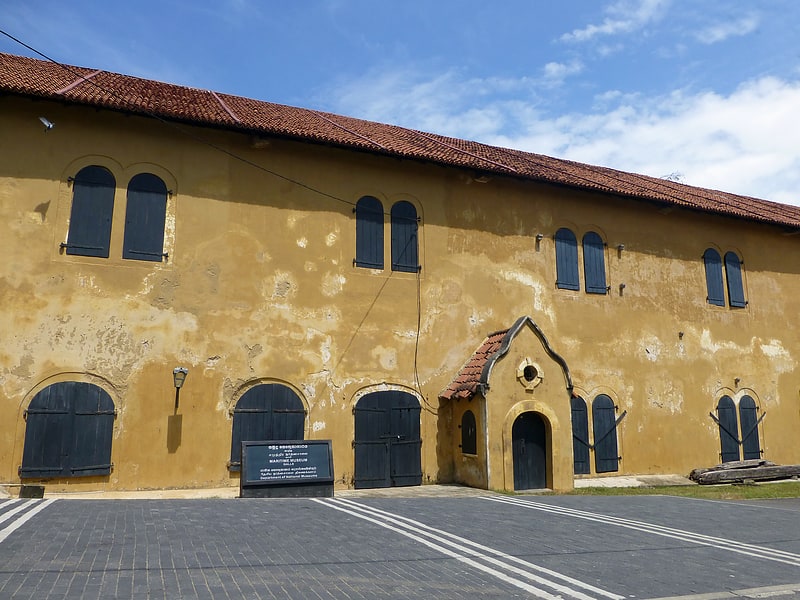
Also known as: ගාල්ල කෞතුකාගාරය
Museum. The National Maritime Museum or National Maritime Archaeology Museum in Galle, Sri Lanka is situated within Galle Fort. It was first opened to the public on 9 May 1992 and is located in a 1671 Dutch Warehouse above the Old Gate of Galle Fort. Whilst the building housing the museum survived the impact of the 26 December 2004 tsunami, the adjoining UNESCO Maritime Archaeology Unit was completely destroyed and all the exhibitions were flood damaged and the majority of maritime archeological artifacts were lost. Under Sri Lanka – Netherlands Cultural Co-operation Program, the Royal Government of Netherlands provided financial assistance for reconstruction of the Maritime Museum. After 3 years period of reconstruction, the Maritime Museum was re-opened to the public.[12]
Address: queens street, galle fort, 80000 ගාල්ල
Jetavanaramaya, Anuradhapura
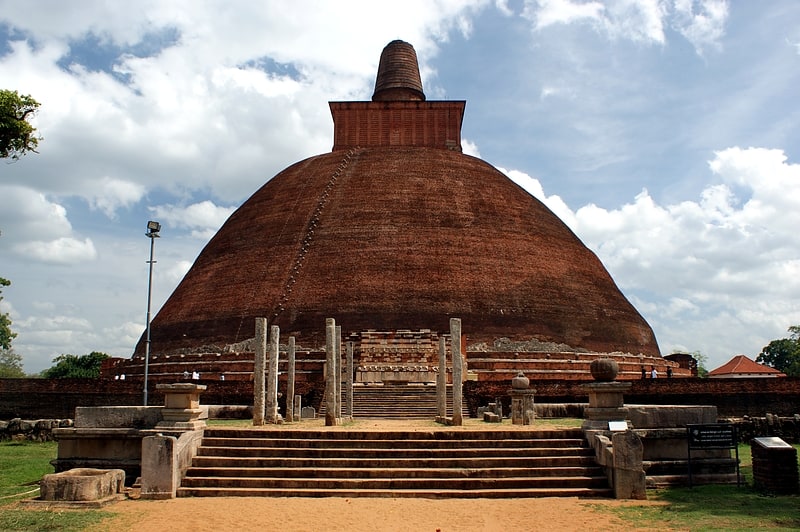
Also known as: අනුරාධපුර ජේතවනාරාමය
Stupa known as the world's largest. The Jetavanarama stupa or Jetavanaramaya is a stupa, or Buddhist reliquary monument, located in the ruins of Jetavana monastery in the UNESCO world heritage city of Anuradhapura, Sri Lanka. At 122 metres, it was the world's tallest stupa, and the third tallest structure in the world when it was built by King Mahasena of Anuradhapura. He initiated the construction of the stupa following the destruction of the Mahaviharaya of Anuradhapura. His son Maghavanna I completed the construction of the stupa, and it was renovated by Parakramabahu I of Polonnaruwa. A part of a sash or belt tied by the Buddha is believed to be the relic that is enshrined here.
The structure is significant in the island's history as it represents the tensions within the Theravada and Mahayana sects of Buddhism; it is also significant in recorded history as one of the tallest structures in the ancient world; and the tallest non-pyramidal building; the height of the stupa was 122 metres, making it the tallest stupa in the ancient world. With the destruction and abandonment of Anuradhapura kingdom in the 11th century, the stupa with others was covered by jungle. King Parakramabahu in 12th century tried to renovate this stupa and it was rebuilt to the current height, a reduction from the original height. Today it stands at 71 metres.
The compound covers approximately 5.6 hectares and is estimated to have housed 10,000 Buddhist monks. One side of the stupa is 176 m long, and the flights of stairs at each of the four sides of it are 9 m wide. The doorpost to the shrine, which is situated in the courtyard, is 8 m high. The stupa has a 8.5 m deep foundation, and sits on bedrock.
The structure is no longer the tallest, but it is still the largest, with a base-area of 233,000 m2. Approximately 93.3 million baked bricks were used in its construction; the engineering ingenuity behind the construction of the structure is a significant development in the history of the island.[13]
Address: B341 Watawandana Road, Anuradhapura
Galle, Galle
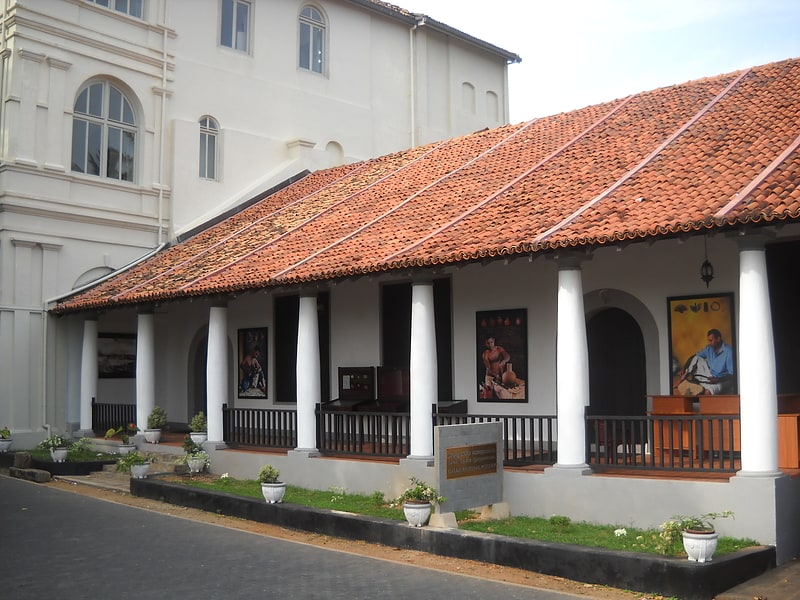
The National Museum of Galle is one of the national museums of Sri Lanka. It is located in the oldest remaining Dutch building in the Galle fort, Galle, a single storey colonnaded Dutch building built in 1656 as the commissariat store for the Dutch garrison at the fort. It subsequently served as a billiards room for the adjoining New Oriental Hotel. The building was renovated by the Department of National Museums and opened on 31 March 1986.
The museum houses a limited collection of exhibits from the Portuguese, Dutch and British periods. It has three main galleries, the first contains collections relating to the area's cottage industries, primarily turtle shell jewellery manufacturing, Beeralu lace weaving and traditional wooden mask carving. The second contains a collection of Dutch period furniture and weaponry. The final gallery, the 'Sri Lanka China Friendship Gallery', was opened on 10 September 2013. It is dedicated to the historical and archeological evidence of trade relations between China and Sri Lanka, with displays on the Chinese Buddhist monk Faxian (337 – c. 422 CE) and the 14th Century Fleet Admiral Zheng He (1371 – 1433).[14]
Address: Church St, 80000 Galle
Koggala Lake, Galle
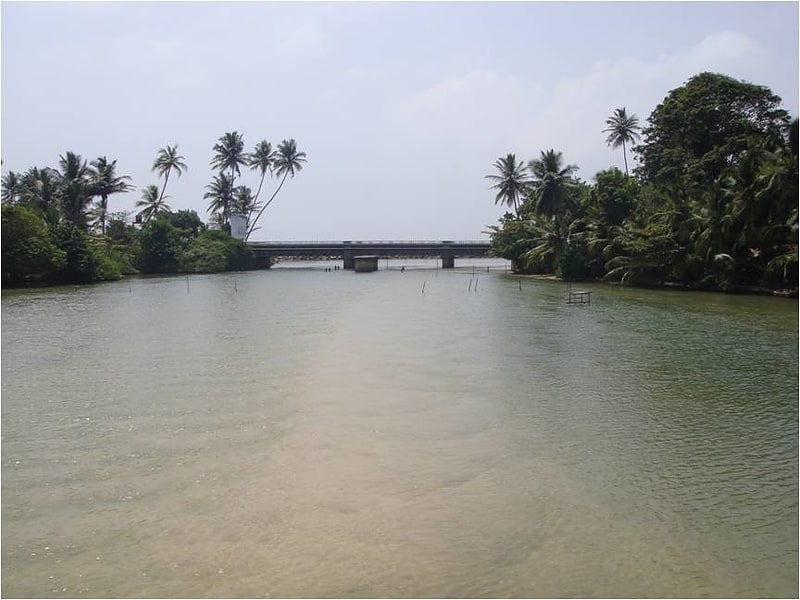
Waterbody. Koggala Lagoon is a coastal body of water located in Galle District, Southern Sri Lanka. It is situated near the town of Koggala and adjacent to the southern coast, about 110 km south of Colombo. The lagoon is embellished with eight ecologically rich small islands.[15]
Satmahal Prasada, Polonnaruwa

The Satmahal Prasada is a 12th century step pyramid in the northeast corner of the archaeological complex of Polonnaruwa in Sri Lanka. It is believed to be a stupa because it is in a Buddhist environment. It is unique in the area, of unknown builder and purpose. It is often compared to the stupa at Wat Kukut in Lamphun in Thailand and to the Buddhist architecture of Cambodia.
According to the Mahavamsa, King Parakramabahu I the Great (1123-1186) built a seven-story tower at Polonnaruwa, but there is no certainty that he refers to this one.
It is made of brick and a layer of plaster. It has seven floors, although the seventh only barely remains. It has a square plan, with a lateral staircase. It presents the same decoration on its four sides. On the ground floor, there is a false entrance. On the upper floors, there is a sculpture at the centre of each wall, surrounded by an arch and holes for anchoring a niche or a similar structure.
It has been related to the pyre of Hephaestion, built in the 4th century BC by Alexander the Great in Babylon to honour that general.[16]
Rankoth Vehera, Polonnaruwa
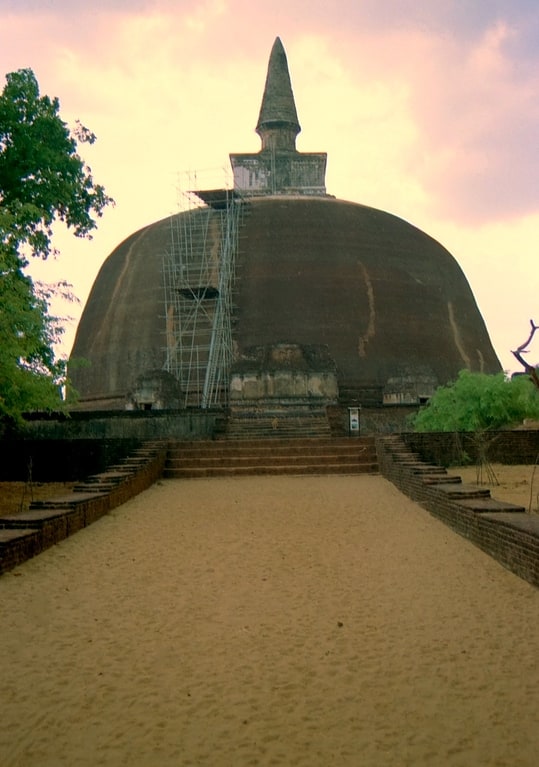
Also known as: රන්කොත් වෙහෙර
Ruin in Polonnaruwa, Sri Lanka. Rankoth Vehera is a stupa located in the ancient city of Polonnaruwa in Sri Lanka. The stupa was built by Nissanka Malla of Polonnaruwa, who ruled the country from 1187 to 1196. The Rankoth Vehera has been built according to the tradition of the stupas of the Anuradhapura Maha Viharaya and bears a close resemblance to Ruwanwelisaya. In fact, a stone inscription situated close to the stupa even identifies it by the name "Ruwanweli". However, it has later come to be known by the currently used name, Rankoth Vehera. In Sinhalese, ran means gold, kotha is the name given to the pinnacle of a stupa, and vehera means stupa or temple. Thus, the name Rankoth Vehera can be roughly translated to English as "Gold Pinnacled Stupa". Along with the Kiri Vehera, it is one of the most revered stupas in Polonnaruwa.[17]
Totapolakanda, Horton Plains
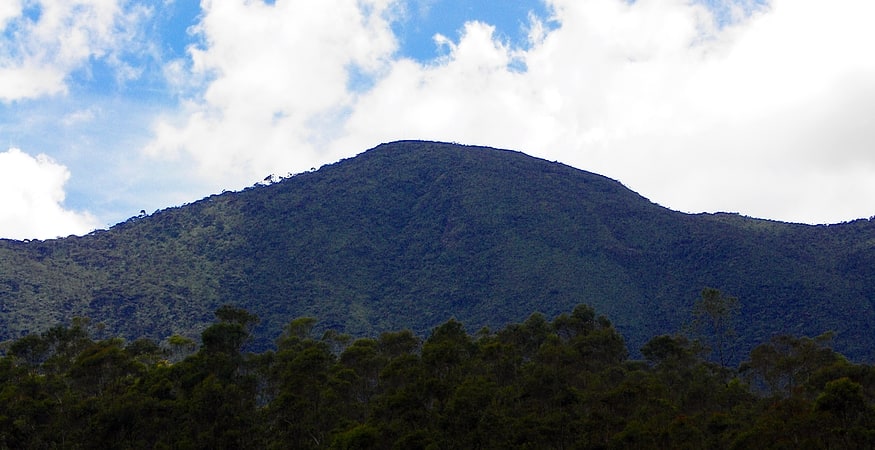
Also known as: තොටුපොල කන්ද
Mountain in Sri Lanka. Totapolakanda, is the third highest mountain in Sri Lanka situated in Nuwara Eliya district 2,357 m above mean sea level. The mountain is located within the Horton Plains National Park. A trail to the top of the mountain, about two kilometres long, starts a few metres away from the Pattipola entrance to the Horton Plains National Park. Most parts of the mountain surface is covered with shrubs adapted to the cool and windy climate of Horton Plains National Park. Strobilanthes, Osbeckia and Rhodomyrtus species grown as shrubs are common among them.[18]
Kirigalpotta, Horton Plains
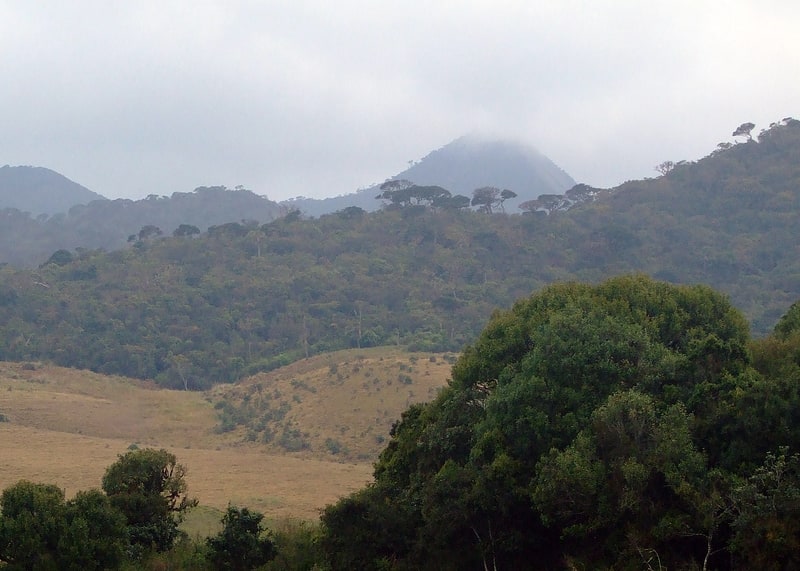
Also known as: කිරිගල්පොත්ත
Mountain in Sri Lanka. Kirigalpotta is the 2nd tallest mountain in Sri Lanka at 2,388 m above mean sea level, and is also the highest mountain in the country whose summit is accessible to the general public. The peak is situated near the city of Nuwara Eliya, within the Nuwara Eliya District. Only one 7 km hiking trail provides access to the mountain's summit via the Horton Plains National Park, although the trail is not very popular.[19]
Gokanna Vihara, Trincomalee
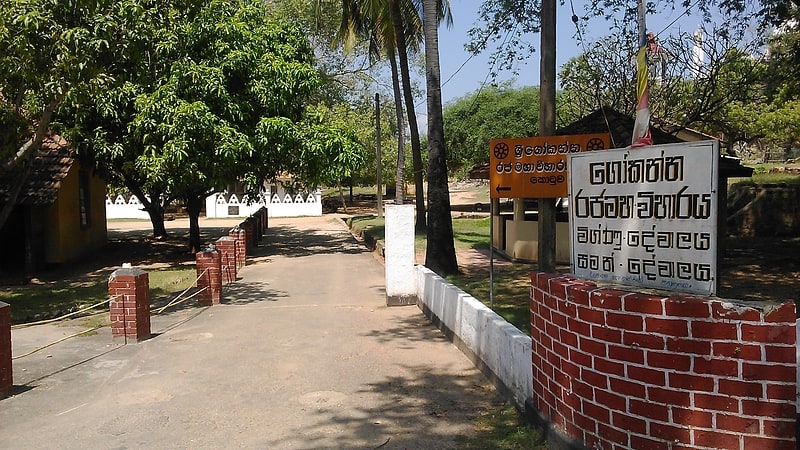
Also known as: ගෝකන්න විහාරය
Temple in Trincomalee, Sri Lanka. Gokanna Viharaya was an ancient Buddhist temple located in Trincomalee in the Eastern Province of Sri Lanka. The temple lies in the premises of Fort Fredrick close to the fort entrance.[20]
Uppuveli, Trincomalee
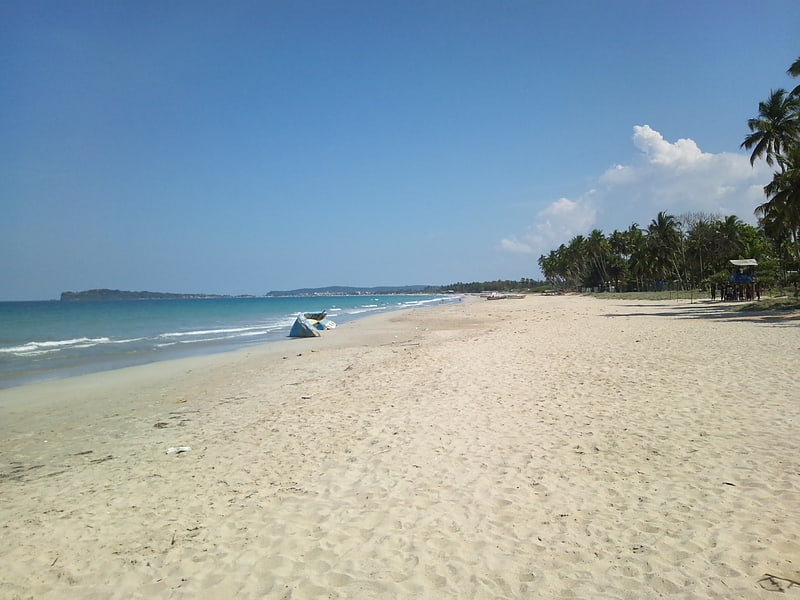
Uppuveli is a gold sand coastal resort town of the Trincomalee District, Sri Lanka located in the suburb of Sambalativu, 6 km northwest of the city of Trincomalee. A historically popular tourist destination of the island alongside the nearby Nilaveli, the numbers of visitors declined following the 2004 Indian Ocean Tsunami and Sri Lankan Civil War, but have risen again since 2010. It is home to the Salli Muthumariamman Kovil on its coast.[21]
Jaffna Fort, Jaffna

Also known as: යාපනය බලකොටුව
Fortress in Jaffna, Sri Lanka. Jaffna Fort is a fort built by the Portuguese at Jaffna, Sri Lanka in 1618 under Phillippe de Oliveira following the Portuguese invasion of Jaffna. The fort is located near the coastal village of Gurunagar. Due to numerous miracles attributed to the statue of Virgin Mary in the church nearby, the fort was named as Fortress of Our Lady of Miracles of Jafanapatão. It was captured by the Dutch under Rijcklof van Goens in 1658 who expanded it. In 1795, it was taken over by the British, and remained under the control of a British garrison till 1948. As the only large military fort in the country, due to the presence of only government and military buildings within its ramparts, it was garrisoned by a detachment of the Ceylon Army.
With the onset of the Sri Lankan Civil War it came under siege on several occasions and was the scene of pitched battles. From 1985 to 1995 it was under the control of the LTTE during this time the LTTE destroyed several of key features to stop the Army getting control due to the site being used to stage attacks but it was recaptured by the Sri Lanka Army in 1995 after a 50-day siege during Operation Riviresa. It was also vandalised by locals to rebuild houses damaged from the war. Today it remains garrisoned by a detachment of the Sri Lanka Army with limited access to visitors and is being renovated with Dutch funding.
Buildings inside the fort include the Governor's residence (King's House), Queen's House, Kruys Church, the Garrison Parade Ground, Police quarters and several buildings from the Portuguese era.[22]
Hunnas Falls, Matale
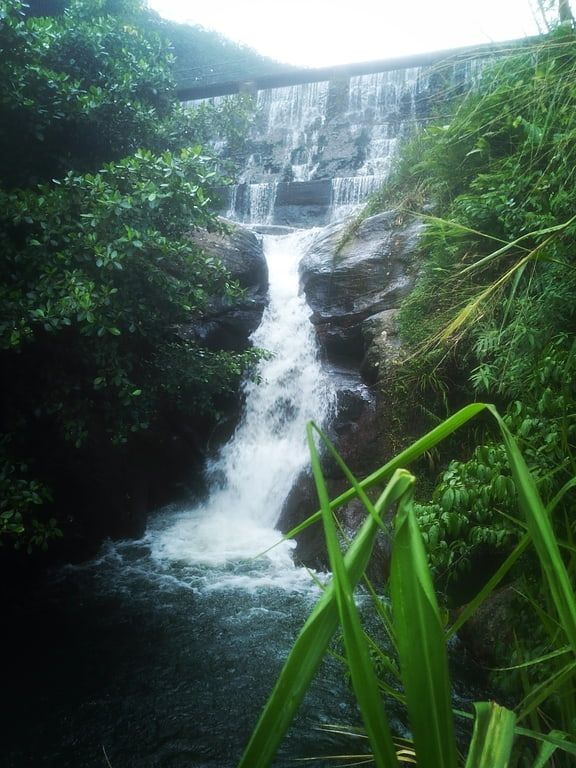
Hunnas waterfall, also known as Hunnasgiriya falls, is located about 22 kilometres from Kandy, Sri Lanka. It is located in Matale District near the village of Elkaduwa. There are two roads to reach Hunnas waterfall, one is coming from Matale to Elkaduwa, the other is Wattegama to Elkaduwa.
This waterfall is 48 metres (157 ft) high and at a height of 1,765 metres (5,791 ft) above sea level. It is a man-made waterfall, which is located in the landscaped garden of the Hunnasgiriya Hotel. It is fed by a stream from the nearby Hunnasgeria mountain peak. Apart from the main fall several streams can be seen during rainy seasons.[23]
Victoria Park, Nuwara Eliya
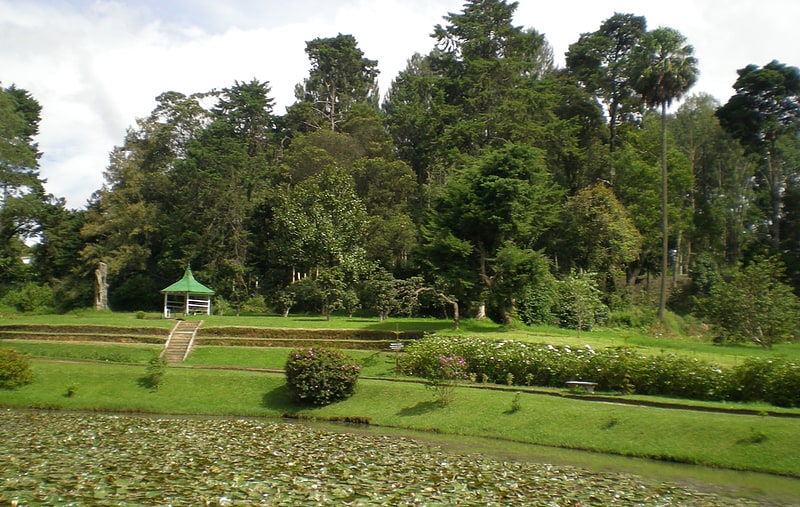
Also known as: වික්ටෝරියා උද්යානය, නුවරඑළිය
Park in Nuwara Eliya, Sri Lanka. Victoria Park is a public park located in Nuwara Eliya, next to the Nuwara Eliya Post Office in Sri Lanka.
Originally the park was the research field of Hakgala Botanical Garden. The park was formally named in 1897 to commemorate Queen Victoria's Diamond Jubilee. The park was established with the planting of its first tree, an Oak, by a visiting German Princess. The Nanu Oya River runs through the park, creating a number of small lakes. A number of rare bird species can be found in the park. At the far end of the park is a small children's playground and miniature ridable railway.[24]
Lake Gregory, Nuwara Eliya
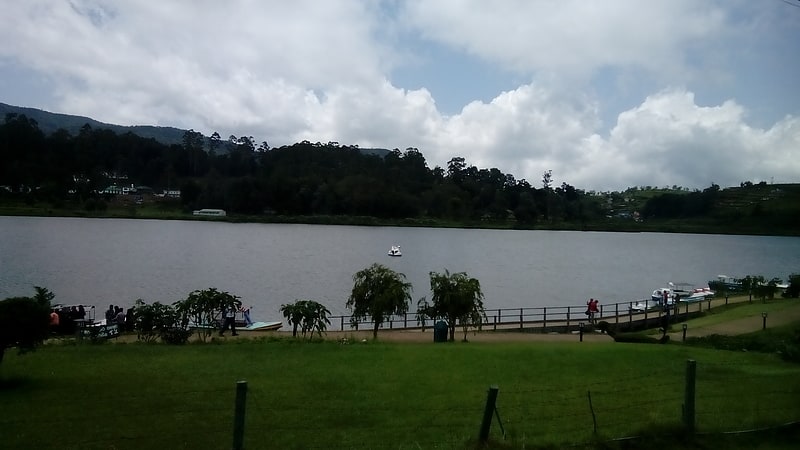
Lake in Sri Lanka. Lake Gregory, sometimes also called Gregory Lake or Gregory Reservoir, is a reservoir in heart of the tea country hill city, Nuwara Eliya, Sri Lanka. Lake Gregory was constructed during the period of British Governor Sir William Gregory in 1873. The lake and the surrounding area make up the Gregory Lake Area.[25]
Kurunegala Clock Tower, Kurunegala
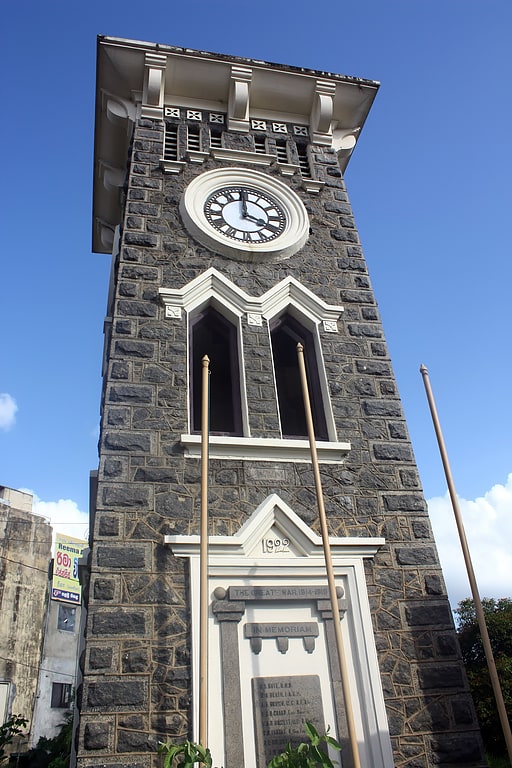
Also known as: කුරුණෑගල ඔරලෝසු කණුව
Historical landmark in Kurunegala, Sri Lanka. The Kurunegala Clock Tower is located in the heart of Kurunegala, Sri Lanka. The clock tower was built in 1922 in memory of the soldiers from North Western Province who participated in the First World War and died. The Kurunegala Court of Law, The Central Market and the Central Bus Stand are also near the clock tower.[26]
Nallur Kandaswamy temple, Jaffna
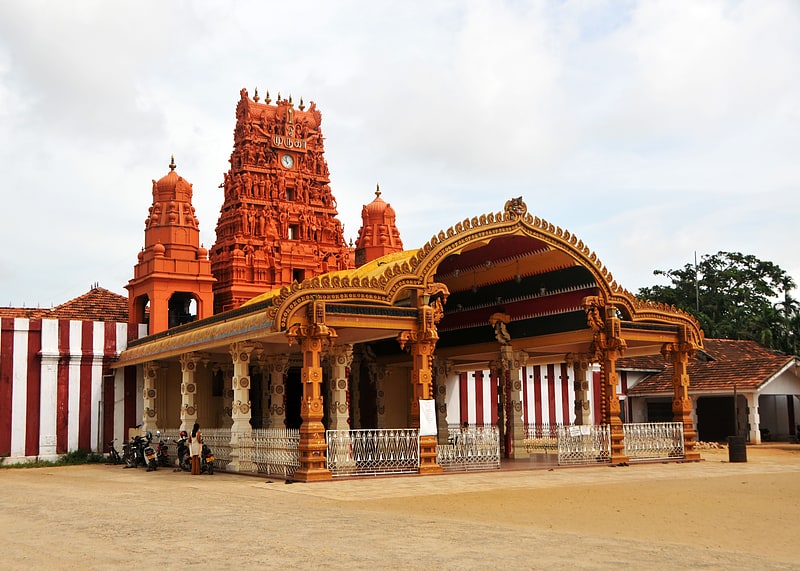
Also known as: නල්ලූර් කන්දස්වාමි කෝවිල
Hindu temple in Jaffna, Sri Lanka. Nallur Kandaswamy Kovil is a significant Hindu temple, located in Nallur, Northern Province, Sri Lanka. The presiding deity is Lord Murugan in the form of the holy 'Vel' in the Sanctum, the primary shrine, and in other forms, namely, Shanmugar, Muthukumaraswami, Valli Kaanthar with consorts Valli and Deivayanai, and Thandayuthapani, sans consorts in secondary shrines in the temple.[27]
Diyaluma Falls, Haputale
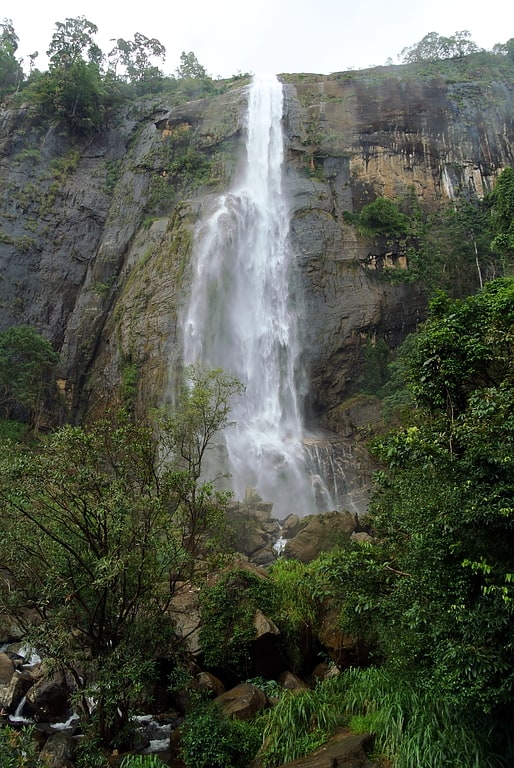
Also known as: දියලුම ඇල්ල
Waterfall in Sri Lanka. Diyaluma Falls is 220 m high and the second highest waterfall in Sri Lanka and 361st highest waterfall in the world. It is situated 6 km away from Koslanda in Badulla District on Colombo-Badulla highway. The Falls are formed by Punagala Oya, a tributary of Kuda Oya which in turn, is a tributary of Kirindi Oya.[28]
Address: Colombo - Batticaloa Hwy, 90190 Koslanda
Pidurutalagala, Nuwara Eliya
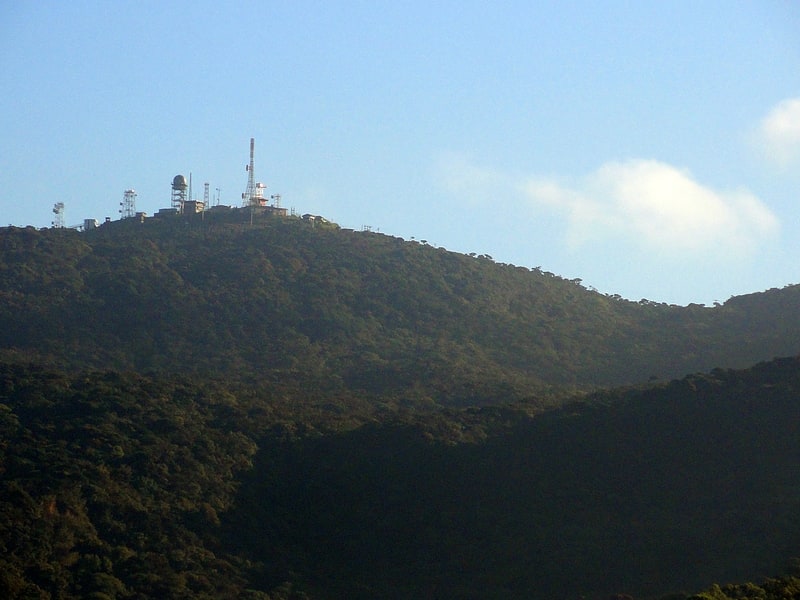
Also known as: පිදුරුතලාගල
Tallest mountain peak in Sri Lanka. Pidurutalagala, or Mount Pedro in English, is an ultra prominent peak and the tallest mountain in Sri Lanka, at 2,524 m. It is situated North-North-East from the town of Nuwara Eliya and is easily visible from most areas of the Central Province. Its summit is home to the central communications array of the Government of Sri Lanka and armed forces and serves as an important point in the country's radar system. The peak is currently designated as an "Ultra-high security zone", and is protected by a large military base; the peak is strictly off-limits to the general public.
On 1 March 2010, a small wildfire broke out over the mountain's forest cover. The fire destroyed 3 acres (0.012 km2) of forest, before being doused by the Sri Lanka Air Force and nearly 300 local residents.[29]
Aluvihare Rock Temple, Matale

Also known as: මාතලේ අළුවිහාරය
Temple. The Aluvihare Rock Temple is a sacred Buddhist temple located in Aluvihare, Matale District of Sri Lanka. Surrounded by hills, the Aluvihara cave temple is situated 30 km north of Kandy on the Matale-Dambulla road. The history of Aluvihare Rock Temple is traced back to the 3rd Century B.C to the reign of King Devanampiyatissa. It is believed that the King built the dagoba, planted the Bo sapling and founded the temple after the introduction of Buddhism to the country during his reign.
Aluvihare Rock Temple was the historic location where the Pāli Canon was first written down completely in text on ola (palm) leaves. Many monastery caves, some of which exhibit frescoes are situated near this temple.[30]
Address: Jaffna - Kandy Road, Matale
Cathedral of Christ the King, Kurunegala
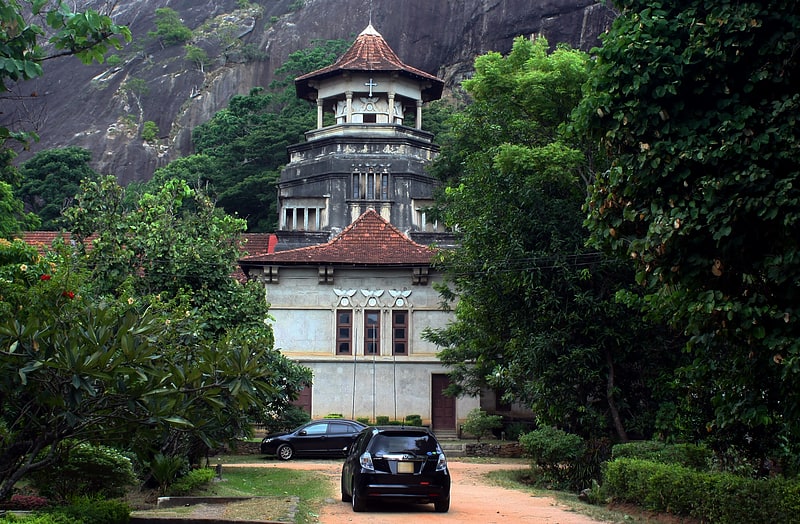
Church in Kurunegala, Sri Lanka. Cathedral of Christ the King is located on Kandy Road, Kurunegala, Sri Lanka. It is the primary Anglican cathedral of the Diocese of Kurunegala, affiliated to the Church of Ceylon.
The construction of the church (estimated at a cost of Rs 500,000) was largely funded by Most Rev. Lakdasa De Mel, the first Bishop of Kurunegala, along with other members of the De Mel family. The construction of the church commenced on 21 December 1950 (the feast of St. Thomas), upon a 1.4 hectares (3.5 acres) site, at the base of Ethagala (Elephant Rock). The chapel of the Blessed Virgin and St. Thomas the Apostle were consecrated in 1956, the ceremony was presided over by Rev. Aurobindo Nath Mukherjee, Metropolitan of India, Pakistan, Burma and Ceylon. The nave, the font, the pulpit and the lectern were consecrated in 1960. The architecture, especially the nave and roof is a combination of Polonnaruwa and Kandy era architecture, reflecting the brick vaulted image houses (Polonnaruwa) and the Temple of the Sacred Tooth Relic (Kandy). The cathedral is constructed out of cement and reinforced concrete. The central tower is 33 metres (108 ft) high and crowned by a bronze cross. The brass lamps and the communion rails depict art motifs and lacquer work of Kandyan tradition. The 'Cross of Anuradhapura' is also replicated in brass. The flags of the ‘Disavas’ (the traditional districts), which constituted the Diocese of Kurunegala, have been reproduced by Ena de Silva and are displayed on an interior wall of the cathedral. The modern painting, by Nalini Marcia Jayasuriya, forms the backdrop to the Lady Chapel and the fresco of Christ the King was painted by George Keyt.[31]
Archaeological Museum, Jaffna
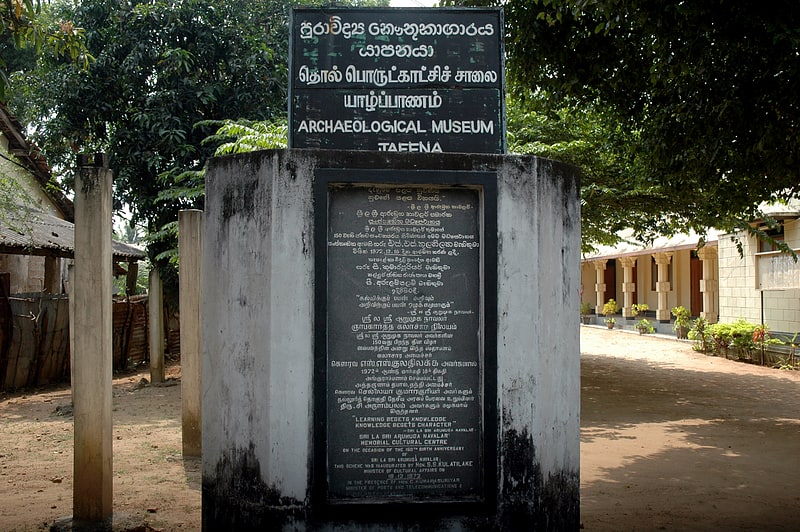
Also known as: යාපනය පුරාවිද්යා කෞතුකාගාරය
Museum in Jaffna, Sri Lanka. Jaffna Archaeological Museum is located in Nallur, Jaffna, Sri Lanka. The land was given to museum by Arumuga Navalar Foundation, and front portion has Navalar Cultural Hall. The museum houses a rare collection of antiquities. Buddhist and Hindu religious collection are in big collection, which are in various forms of metal, wood and stone. The excellent collections begin in time from the period of ancient period Sri Lanka to the colonial era. Also, some of the archaeological excavations findings of Kandarodai can seen at this museum.[32]
Dondra Head Lighthouse, Matara
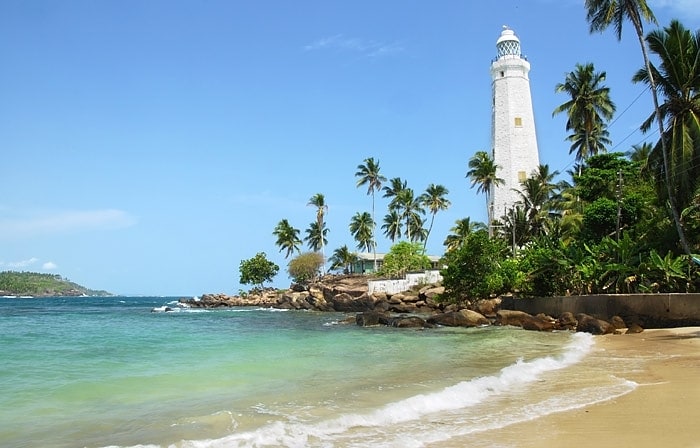
Also known as: දෙවුන්දර තුඩුව ප්රදීපාගාරය
Lighthouse in Sri Lanka. Dondra Head Lighthouse is a lighthouse located on Dondra Head, Dondra, the southernmost point in Sri Lanka and is Sri Lanka's tallest lighthouse, and also one of the tallest in South East Asia. Dondra Head lighthouse is operated and maintained by the Sri Lanka Ports Authority.
The lighthouse is near the village of Dondra, and is approximately 6 km (3.7 mi) southeast of Matara. The name Dondra is a synonym for "Devi-Nuwara" in the local Sinhala language, "Devi" meaning "Gods" and "Nuwara" meaning "City". Dondra is therefore derived to mean "City of the Gods".[33]
Address: Light House Road, 81000 Dondra
Sithulpawwa Rajamaha Viharaya, Yala National Park

Also known as: සිතුල්පව්ව රජ මහා විහාරය
Monastery. Sithulpawwa Rajamaha Viharaya is an ancient Buddhist monastery located in Hambantota District, South Eastern Sri Lanka. Situated 18 km east of the pilgrimage town Katharagama, it is believed to have been built in the 2nd century B.C by king Kavantissa. Sithulpawwa Vihara can be reached by travelling 18 miles along the Tissamaharama-Yodhakandiya road towards the Yala National Park. The name Sithulpawwa is derived from the word "Chiththala Pabbatha", which means "the hill of the quiet mind".
This monastery was a place of worship for devotees as well as a center of Buddhist education for Buddhist monks. Paintings of the Anuradhapura era and the ruins of stone Buddha images, Bodhisattva images, Image Houses, Circular Relic Houses are spread throughout the monastery premises. The present chief incumbent of Sithulpawwa Rajamaha Vihara is Ven. Metaramba Hemarathana Nayake Thera.
King Gajabahu placed a stone inscription where it states that the tax received from the court must be paid to the monks of this monastery.[34]
St. Andrew's Church, Haputale
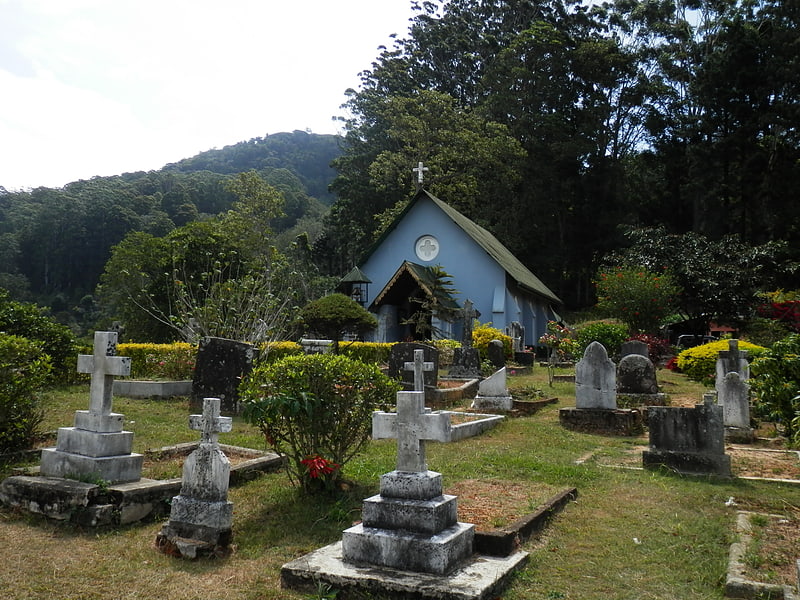
St. Andrew's Church is an Anglican church in Haputale, Badulla District, Sri Lanka. This small Neo-gothic church is located on the A16 road.
It is one of the oldest buildings in Haputale and one of the oldest European buildings in the district. The foundation stone was laid on 7 April 1869 by Lieutenant General Hodgson and it was consecrated for worship on 19 September 1869.It was built by James Andrews, who worked at Sherwood Estate, and Richard Wylie, from Pita Ratmale Estate. The first services were conducted by Rev. Joseph Barnett, co-pastor of Middlington.
The church's interior is small but well furnished. The pews and kneelers are upholstered with red velvet and leather and the ends of the pews are decorated with intricate woodcarvings. The altar is surrounded by stained glass windows imported from Scotland that depict the significant events in the life of Jesus. It has a marble baptismal font, imported from England, located at the entrance of the church.
Reverend Walter Stanley Senior's ashes are interred in the church's graveyard.
The church was declared a protected archaeological site in November 2002.[35]
Address: Beragala-Hali Ela Highway, Haputale
Batticaloa Lighthouse, Batticaloa
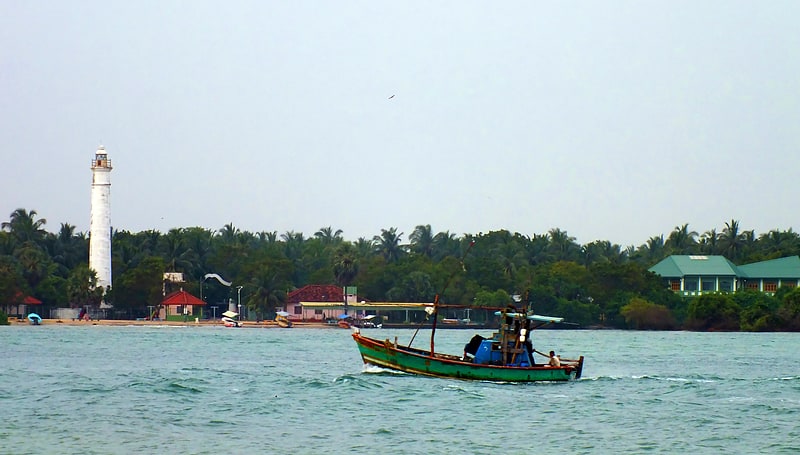
Also known as: මඩකලපුව ප්රදීපාගාරය
Historical landmark in Batticaloa, Sri Lanka. Batticaloa Lighthouse is a lighthouse in Sri Lanka, situated near the estuary in Palameenmadu. It was built in 1913 and is 28 meters high.[36]
Address: Bar Road, 30000 Batticaloa
Batticaloa fort, Batticaloa
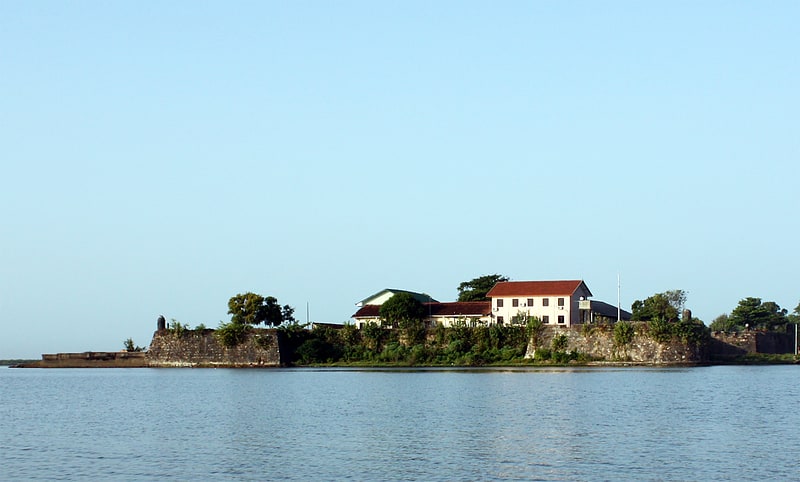
Also known as: මඩකලපුව බලකොටුව
Ruins of a waterside fort built in 1628. The Batticaloa Fort was built by the Portuguese in 1628 and was captured by the Dutch on 18 May 1638. From 1795, the fort was used by the British.
The fort has a structure of four bastions and is protected by the Batticaloa Lagoon on two sides and a canal on the other two sides. The fort is still in reasonable condition and currently houses several local administrative departments of the Sri Lanka government in new buildings, which are located within the old structure.[37]
Sri Muthumariamman Temple, Matale
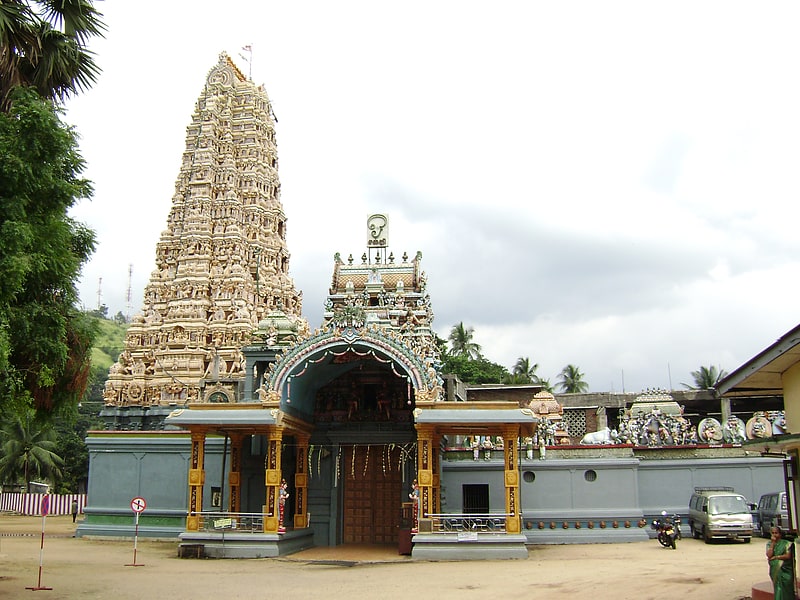
Hindu temple in Matale, Sri Lanka. Muthumariamman Temple or Arulmigu Sri Muthumari Amman Kovil is a Hindu temple in Matale, Sri Lanka.
The prefix “Muthu”, literally means “pearl”. "Mari" means rain and "Amman" means mother in Tamil language. The temple is dedicated to Mariamman, the goddess of rain and fertility. The chariot festival in this temple is held usually coinciding with Magam on a Full Moon Poya Day.[38]
Ibbagala Raja Maha Vihara, Kurunegala
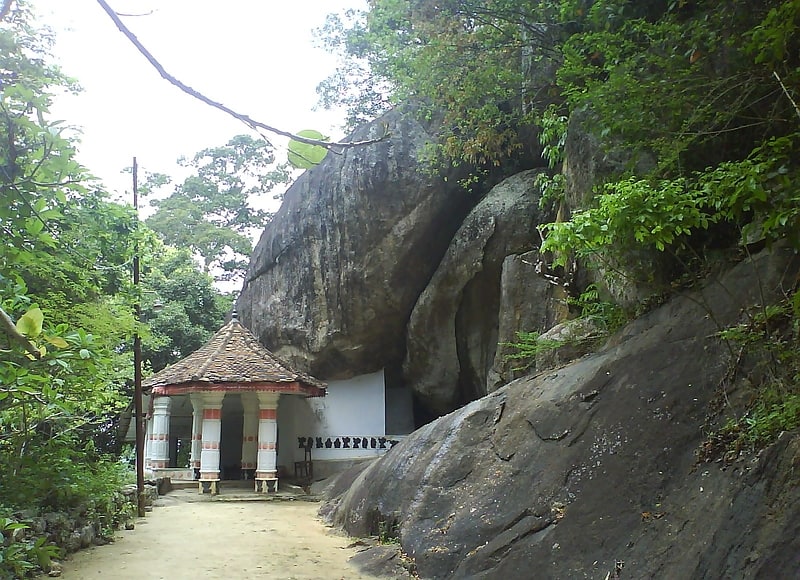
Also known as: ඉබ්බාගල රජ මහා විහාරය
Ibbagala Raja Maha Vihara is an ancient Cave temple in Kurunegala District, Sri Lanka. The temple is situated in middle of the Kurunegala town and lies in the mid valley area of the Ethagala Rock. The temple has been formally recognised by the Government as an archaeological site in Sri Lanka.[39]
Brief Garden, Beruwela

Brief Garden is a landscape garden and former home in Beruwala, Sri Lanka designed by landscape architect and owner Bevis Bawa. It is home to the landscape design practice, Brief Garden Designs.
In 1929 Bawa was bequeathed the family rubber plantation by his mother, Bertha Marianne née Schrader (1876–1946). The estate's unique name was derived from the fact it was purchased by his father, Benjamin, with funds from a successful legal brief. Bawa realised that he lacked the self-discipline to operate and maintain a successful plantation and focused instead on developing the estate's garden. The original estate was approximately 81 hectares (200 acres) with Bawa selling off portions of the estate to reduce it to manageable proportions. He continually worked on the garden until his death in 1992. The estate was inherited by his employees, with Doohlan de Silva, currently managing the property.[40]
Address: Kalawila Village, Beruwela
Saint Stephen's Church, Negombo
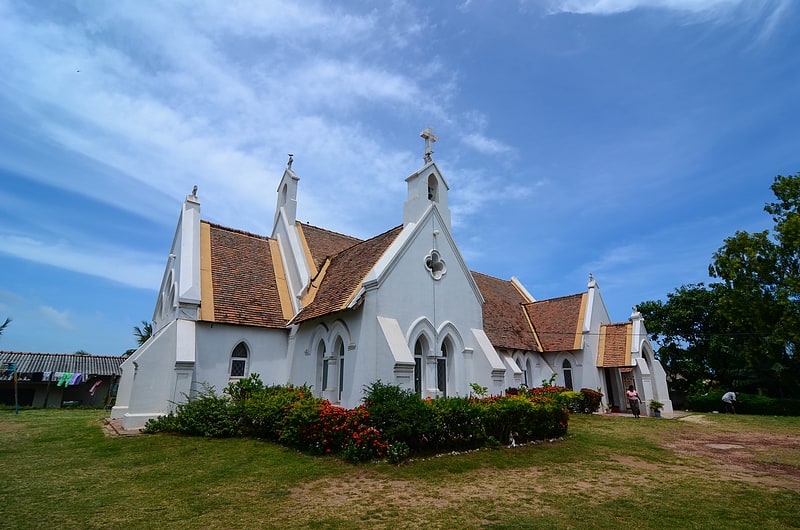
Saint Stephen's Church, Negombo, is an Anglican church in Negombo, Sri Lanka. It was consecrated on 31 July 1880 in the presence of dedicated devotees which included several Wesleyans. Service was also conducted in the Sinhalese language on the occasion when a Sinhalese woman was also baptised, under the sponsorship of two English women.[41]
Kallady Bridge, Batticaloa
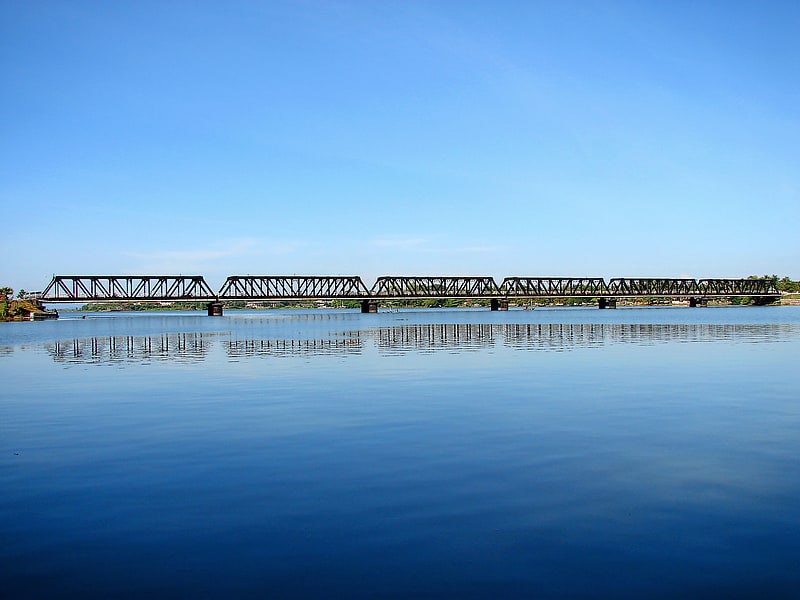
Also known as: කල්ලඩි පාලම
Truss bridge in Sri Lanka. Kallady Bridge is a road bridge in eastern Sri Lanka. It crosses the Batticaloa Lagoon at Batticaloa. The bridge is part of the A4 Colombo-Batticaloa highway.[42]
Adisham Hall, Haputale
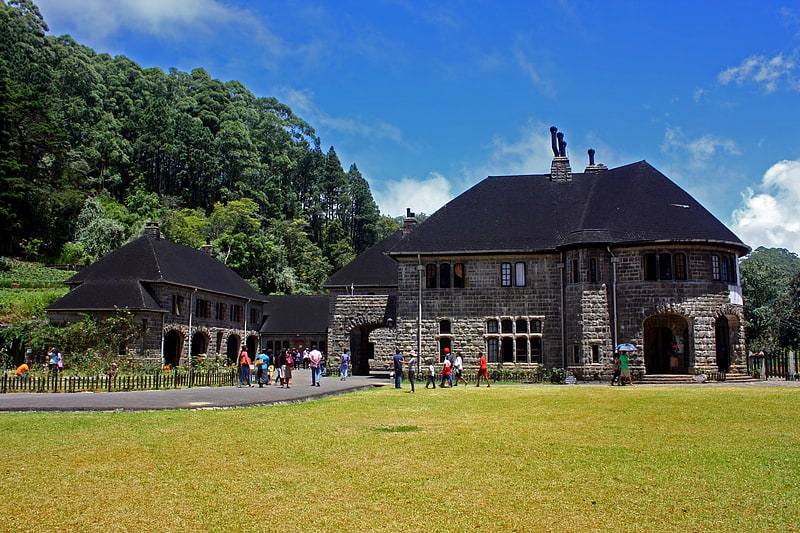
Also known as: එඩිෂම් බංගලාව
Historical landmark in Sri Lanka. Adisham Hall, or Adisham Bungalow is a country house near Haputale, in the Badulla District, Sri Lanka. At present, it houses the Adisham monastery of Saint Benedict. It has a relic of St. Sylvester at the chapel.
Sir Thomas Villiers was awarded 2.8 ha (7 acres) from the Tangamale Strict Nature Reserve by an act of the British parliament. The house was built in 1931 by an English aristocrat and planter Sir Thomas Villiers, former Chairman of George Steuart Co, a trading and estate agency based in Colombo. Sir Thomas was a grandson of Lord John Russell and descendant of the Dukes of Bedford. Named after Adisham, it was designed by R. Booth and F. Webster in Tudor and Jacobean style. Adisham Hall played host to many prominent personalities of the colony until the retirement of Sir Thomas, after which it was purchased by Don Charles Wijewardene and his daughter Rukmini Wijewardene, owners of Sedawatte Estates, in 1950. While studying at LSE, London, Rukmini Wijewardene, in order to thank him for the sale, made a courtesy call on Sir Thomas Villiers who was, by then, living in Knightsbridge, London. Don Charles and Rukmini were the husband and daughter of Vimala Wijewardene. In 1961 Rukmini Beligammana (née Wijewardene) sold it to an Italian Benedictan monk. Upon purchasing the house and property the Italian monk removed silver cutlery and a few items of furniture in order to recover his investment and also make a profit. After leaving it unoccupied for two years he subsequently donated the house and property to the Ampitiya Benedictine Monastery in 1963. The house is well preserved along with its period fittings and furniture, and is open to visitors.[43]
Address: Haputale, St. Benedict's Monastery, Adisham, Haputhale, Sri Lanka
Muththumari Amman Temple, Negombo
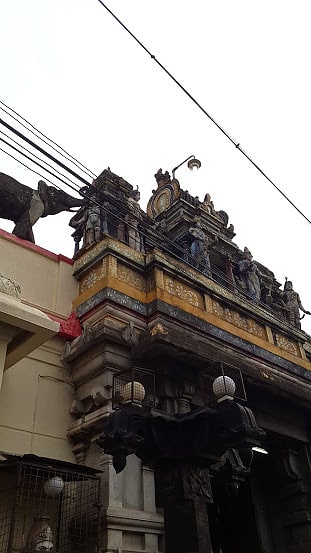
Hindu temple in Negombo, Sri Lanka. Sri Muthumariamman Temple is one of the famous Mariamman temples in Negombo built in a facet clicking back to the syles of Dravidian architecture. The temple still remains in an old fashioned pose. The engravings of the granite architecture in the temple is what that holds a reputation to the Negombo Tamils there as one of the most powerful temples where pujas and offering made, provide benefits to the public.[44]
Al Abrar Mosque, Beruwela
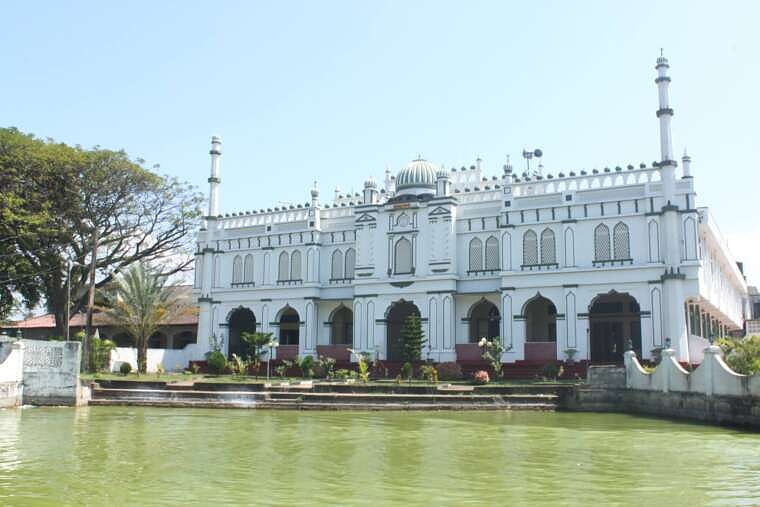
Al Abrar Mosque, or Masjidul Abrar Jumma Mosque, is a mosque in Beruwala, Sri Lanka, which is claimed to be the first and the oldest mosque in the country.
The mosque purportedly dates back to 920 AD, built by Arab merchants who arrived here to trade with locals in spices, ginger and steel en route to China. The mosque, fronted by a large pond, has undergone several extensive reconstructions since it was first built, with little attention paid to preserve any historical aspects of the structure. In 1893 the roof was supported by large round pillars, which were demolished in 1986 when the mosque went through a significant refurbishment and expansion, under the guidance and supervision of Abdul Bakeer Markar, the local member of parliament, representing Beruwala, who later went on to become the Speaker of the Parliament and the first Governor of the Southern Province. The renovated building was designed by W. J. Neil Alles of Surti and Alles Chartered Architects and built by Alhaj S. M. A. Hameed and M. N. A. Haniffa. The mosque currently has the capacity to accommodate 3,000 devotees.
On 8 June 2003 an image of the mosque was included on two commemorative stamps (a Rs.23 and Rs.4.50), released by the Postal Department to mark the first Arab settlement by the Media, Postal and Telecommunications Minister Imthiaz Bakeer Markar.[45]
Matara Bodhiya, Matara
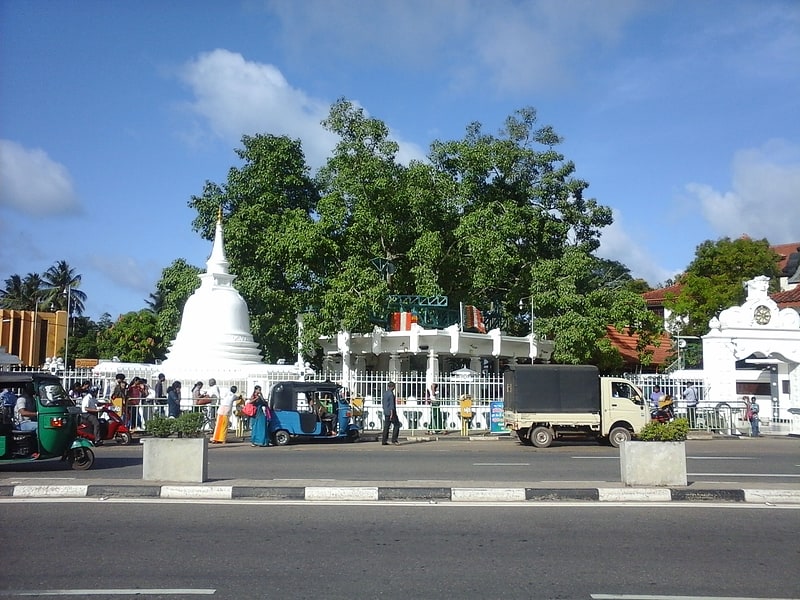
Also known as: මාතර බෝධිය
Matara Bodhiya is a sacred fig tree in Matara, Sri Lanka.
Its origin can be traced back to a tragic story centred on King Kumara Dharmasena or Kumaradhatusena son of King Kasyapa of Sigiriya (512-522 AD) and his closet friend, Kalidasa, a famous dramatist and poet. According to the tale the king whilst in the amorous company of a courtesan, spied a bee entangled in the petals of a lotus flower, inspired he wrote two poetic lines. He then offered a reward to anybody who could complete the other two stanzas to his poem. The cunning courtesan seized the opportunity took the verse to Kalidasa, who completed the poem. The courtesan then murdered Kalidasa in order to keep the reward for herself, concealing the body. The king however instantly recognised his friend's handwriting bringing the whole murderous ruse to light. When Kalidasa's dead body was taken to the funeral pyre for cremation, the grieving king unable to control his grief over the death of his beloved friend, threw himself into the burning flames and immolated himself. Upon witnessed this tragedy, five official queens also leapt into the flames to their deaths.
Local legend has it that seven Bo trees were planted over the seven tombs. These seven Bo trees are known locally as the "Hath Bodhis" and are said to be still surviving at six different places around Matara. Matara Bodhiya is one of those trees. It is respected and protected by the local buddhists.
In 1783 when the Dutch ruled Matara, a Dutch General is alleged to have cut down those seven Bo trees and had used their timber for the construction of local buildings, with only one having survived.[46]
Address: Town Centre, 81000 Matara
St. Sebastian’s Church, Negombo

Catholic church in Negombo, Sri Lanka. The St. Sebastian's Church, Negombo, also known as St. Sebastian's Church, Wellaweediya, is a Roman Catholic church in Negombo, in Sri Lanka. It is architecturally based on the Reims Cathedral in France and is built in Gothic Revival style. Saint Sebastian is the patron saint of the city of Negombo.[47]
Address: 207 Sea St, Negombo
Lahugala Kitulana National Park, Yala National Park
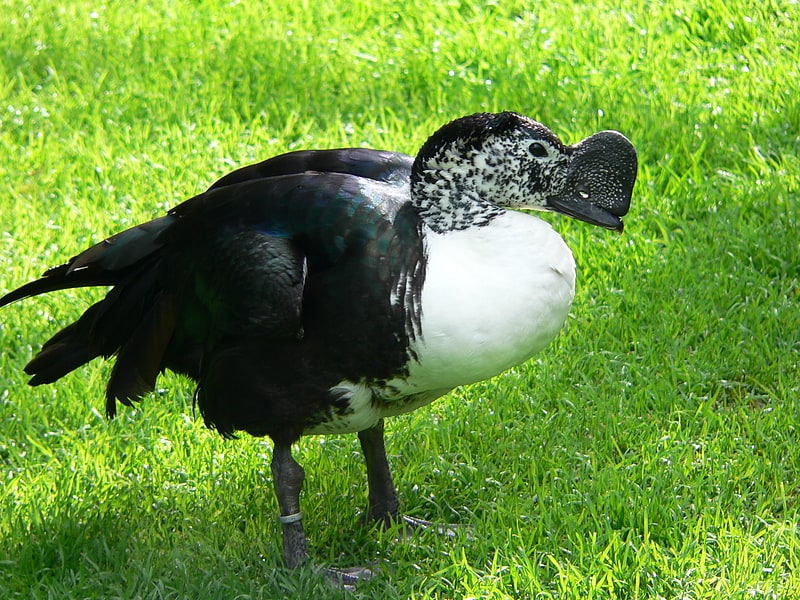
Also known as: ලාහුගල කිතුලාන ජාතික උද්යානය
National park in Sri Lanka. Lahugala Kitulana National Park is one of the smallest national parks in Sri Lanka. Despite its land area, the park is an important habitat for Sri Lankan elephant and endemic birds of Sri Lanka. The national park contains the reservoirs of Lahugala, Kitulana and Sengamuwa and they are ultimately empties to Heda Oya river. Originally it was designated as a wildlife sanctuary on July 1 of 1966. Then the protected area was upgraded to a national park on October 31 of 1980. Lahugala Kitulana is situated 318 km east of Colombo.[48]
Matara fort, Matara
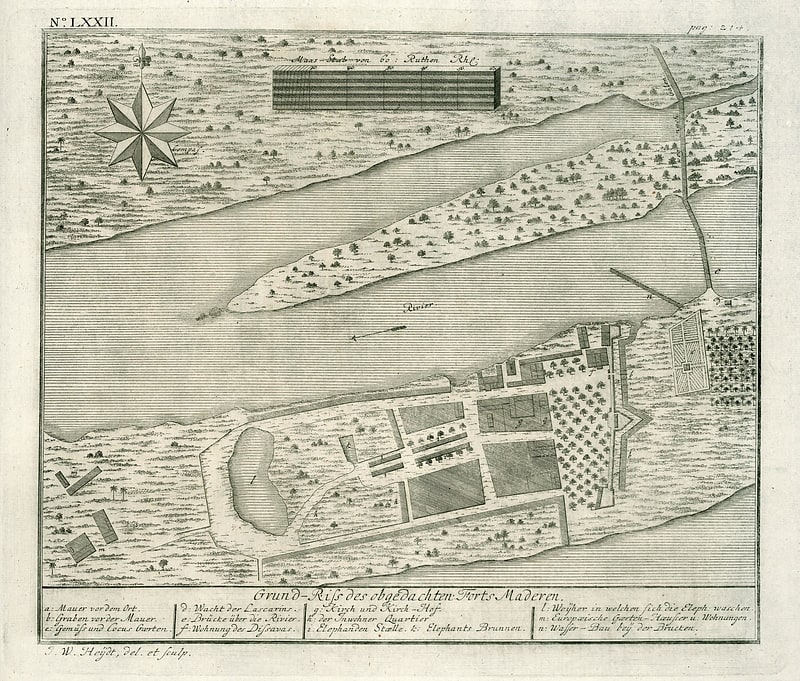
Also known as: මාතර බලකොටුව
Historical landmark in Matara, Sri Lanka. The Matara Fort was built in 1560 by the Portuguese and was substantially re-built by the Dutch in 1640, following the capture of Galle. The fort, which consists of a large stone rampart, occupies the promontory, which separates the Niwala Ganga lagoon and the ocean.[49]
Lahugala Kota Vehera, Yala National Park
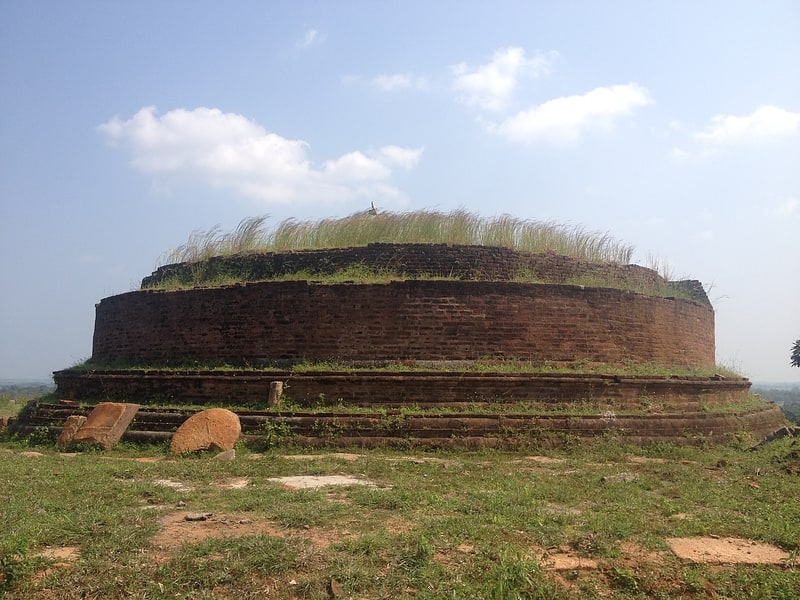
Also known as: ලාහුගල කොට වෙහෙර
Temple. Lahugala Kota Vehera or Kota Vehara Raja Maha Vihara is an ancient Buddhist temple situated in Lahugala, Ampara District, Sri Lanka. The temple is located in Pansalgoda Grama Niladari division of Lahugala DS and lies on Colombo - Batticaloa main road about 10 km far from Pothuvil town. The temple has been formally recognised by the Government as an archaeological site in Sri Lanka. The designation was declared on 10 October 2014 under the government Gazette number 1884. The protected monuments include the ancient Dagaba, building sites with stone pillars, flight of steps carved on natural rock plain and drip ledged caves. The Stupa in the Vihara has been identified as one of four Kota Vehera Styled structures found around Sri Lanka.[50]